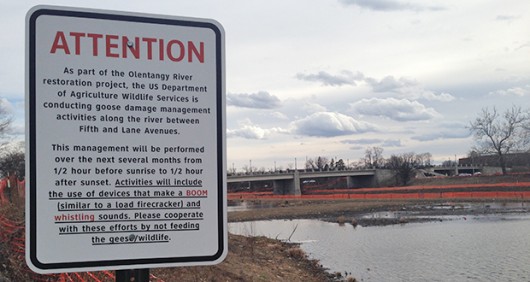
Pyrotechnic devices and lasers have returned to the Olentangy River this week as part of a continued effort to drive geese from the area, spurred by the success of similar approaches used last year. Credit: Eric Weitz / Lantern reporter
Pyrotechnic devices and lasers have returned to the Olentangy River this week as part of a continued effort to drive geese from the area, spurred by the success of similar approaches used last year.
George Zonders, a spokesman for the Columbus Department of Public Utilities, said that after having success last year with the goose-related damage management techniques, the City of Columbus and the United States Department of Agriculture are continuing their efforts to prevent the geese from eating vegetation planted as part of the Olentangy River Restoration Project.
“When we did the restoration work last year, we got a lot of good growing time in due to the previous efforts by the USDA team,” Zonders said. “This is mainly a pre-emptive effort again to get through the nesting and mating periods of the geese to keep them from settling.”
“There was some good momentum last year,” he said of plant growth in the area between Fifth and Lane avenues. “We want to keep that momentum and give the growth more time to get established.”
The City of Columbus and the USDA Wildlife Services conducted similar efforts last year, using pyrotechnic devices and lasers in addition to other measures to drive geese from the area.
“The pyrotechnics and the lasers are all designed to do the same thing, to startle them and to keep them from settling in any one particular place, not to injure (them),” Zonders said. “You are basically trying to startle them to get them to move somewhere else. In the middle of the river is fine, as long as they are not settling down and eating the new growth that we are trying to encourage this spring.”
Last year, efforts to remove the geese from the area were scheduled to run from March to December or until the “vegetation matured,” according to an OSU press release.
Zonders said the pyrotechnics and lasers will be less frequent this year and on an “occasional and as-needed basis,” adding that the city’s contract with USDA expires at the end of July, but could be discontinued earlier if the team determines that the deterrent practices are no longer needed.
Clintonville resident Kayla Newkirk walks along the Olentangy Trail from her home north of campus every day. She said that she has never seen USDA officials near the river or heard the explosions but has noticed the warning signs and the smaller number of geese in the targeted area.
“Toward Clintonville, I see a lot of them,” she said. “There are a lot more geese north of campus, but down here, I don’t see them as often.”
Newkirk said that when she sees geese south of the Lane Avenue, they are often in the water and not in the vegetation near the trail.
Administration and Planning spokeswoman Nicole Holman said in an email while the university “is not financially involved in the efforts to deter the geese,” it did contribute $2 million to the $6.9 million Olentangy River Restoration Project, which is part of the One University Framework Plan.
In August 2012, the Olentangy River renovation began with the partial removal of the Fifth Avenue Dam. About one-third of the structure was removed completely, while along the remaining length of the dam, the top two feet of concrete were removed and the rest was covered with soil.
The One University Framework Plan is a long-term university initiative that the Board of Trustees approved in June 2010. It is used to guide OSU’s project decision making, according to the Facilities Operations and Development (FOD) website.
The river restoration project will “benefit our campus environmentally, aesthetically and academically, yielding a living-learning laboratory where teaching and research can and will thrive,” Holman said.


